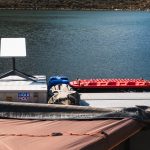If you regularly travel with a motorhome and sometimes camp off-grid for longer periods, you've probably realized how important a reliable energy source is. But what if there isn't enough roof space or you want to stay flexible? That's exactly why we decided to get a foldable solar panel. While it's not a cheap investment, it can prove very useful in the long run. After 8 months of intensive use during our full-time travels, we can confidently say we don't regret the investment.
A foldable solar panel is the perfect solution for campers who want to combine flexibility with performance. Read our experience report to learn everything you need to know about the pros and cons, installation, and usage.
Note: Links marked with an * are affiliate links. If you purchase something through this link, we receive a small commission. The price remains the same for you.

What is a foldable solar panel?
A foldable solar panel* or a foldable solar panel consists of several lightweight solar panels that are unfolded for use and oriented toward the sun. After use, it is folded back up and stored in the vehicle. Solar panels come in various sizes and wattages, similar to fixed solar modules.
What are the pros and cons of a foldable solar panel?
| Advantages of a foldable solar panel | Disadvantages of a foldable solar panel |
| + No installation required, the modules are easy to set up. | – Higher price compared to fixed solar modules. |
| Can be oriented toward the sun , allowing for higher energy yield in the morning and evening. | – Requires storage space inside the camper. |
| + Saves space on the camper roof, which is often crucial for smaller vehicles. | Needs to be set up before use, which takes time. |
| + No drilling into the roof required. | Increased risk of theftwhen the panel is set up outside. |
| – Prone to wind; often can only be placed flat on the ground. | |
| – Not waterproof, can withstand at most a shower, must be brought inside the vehicle during rain (depending on the model). |
Connection of the foldable solar panel
The connection of a foldable solar panel* is straightforward. In addition to the panel, you’ll also need a suitable charge controller to optimally charge the battery. Make sure that the controller is compatible with both your panel and your battery type. We recommend using an MPPT controller, as it is more efficient than a PWM controller and charges the battery faster and more effectively. We use the Victron SmartSolar 100/20 for our foldable solar panel. You can determine which controller is suitable for your panel using the MPPT size calculator berechnen. Beim Anschluss des Ladereglers müssen jeweils Plus- und Minuskabel zur Batterie verlegt werden. Der Regler sollte sich möglichst nah an der Batterie befinden, um Spannungsverluste zu vermeiden. Der Anschluss an die Solartasche erfolgt über Anderson-Stecker, die eine sichere und einfache Verbindung ermöglichen.
Our foldable solar panel
We have decided on the FSP-2 225W Ultra foldable Solarmodul* von Offgridtec entschieden. Dieses verbindet für uns das Optimum aus Leistung (24 % Wirkungsgrad, 225 Watt) und Größe. Bei diesem Panel ist bereits ein Kabel mit Andersonstecker im Lieferumfang enthalten. Das Kabel ist 6 Meter lang und damit lang genug, um das Modul nach Sonnenstand flexibel ausrichten zu können. Zudem wurde ein zweites 0,5m Verbindungskabel mitgeliefert, dass direkt am Solareingang des Ladereglers verschraubt werden muss, und auf der anderen Seite ebenfalls mit einem Anderson Stecker ausgestattet ist. Durch die Andersson Steckverbindung, lässt sich das Modul jeder Zeit unkompliziert anschließen. In 2 Minuten ist unsere Modul aufgebaut und angeschlossen.
For connecting the charge controller to the battery, a 1-meter cable was also included, which was equipped with crocodile clips on the battery side. These fit most common battery terminals. The battery cable also came with a blade fuse and the corresponding ATO fuse.
Important Note: When connecting the cables to the charge controller, the solar panel should not already be connected to the cable while it is in the sun and producing electricity. This could cause damage.
Two charge controllers for one battery?
If you want to operate fixed solar panels and an additional foldable panel at the same time, using two charge controllers* is the simplest solution. Unlike multiple fixed panels, which are connected in series or parallel, it makes sense to control a flexible panel independently. Two charge controllers prevent power losses and inefficient charging. Both controllers can communicate with each other in a virtual network via the Victron app. This allows you to optimize the charging processes and ensure that the battery is always charged in the best possible way, based on the respective conditions of the solar panels. We installed the Victron Smartsolar MPPT 75/15* for the fixed solar panels and the Victron Smartsolar 100/20* for the foldable panel. You can find more information in our article Solar system in the camper.
Conclusion: Is it worth investing in a foldable solar panel?
For us, the answer is clearly yes. Since we work while traveling and need to use two laptops and Starlink on certain days, the limited space on the roof is not enough to collect sufficient solar energy. However, thanks to the additional foldable panel*, we can sufficiently charge our battery without relying on driving between workdays.

